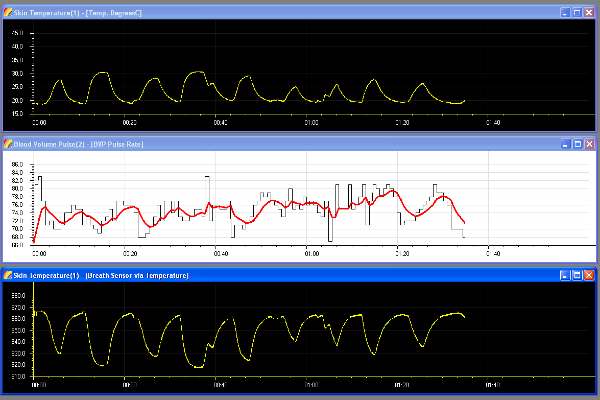Hypnotherapy & Psychotherapy
A growing number of therapists are taking the opportunity provided by the advent of modern microprocessor technology to understand, at a much more profound level, the effects of therapy on the client, at an unconscious level.
"The Vilistus is an invaluable and inexpensive way of monitoring clients altered states of
consciousness during therapeutic work"
-- Alan Jones, NLP Trainer and Hypnotherapist
Accessing the client's sympathetic and parasympathetic nervous system delivers a more accurate indication of emotional state than simply observing external physiological changes. Now you can alter your hypnotic induction or therapeutic intervention by seeing what is really happening rather than relying on either the client telling how they feel or looking for physical "tells".
Vilistus gives you a number of different ways of tapping into the client's unconscious reactions. The sensors can be used singularly or together to deliver an objective, quantifiable and immediate picture of the clients state of mind.
GSR Sensor
The GSR sensor gives the therapist an instant view of the clients state of relaxation and immediately shows any changes in emotional reactions. The GSR sensor is ideal for hypnotherapists or psychotherapists because it shows precisely - and immediately - the effect of therapeutic interventions or hypnotic inductions.
The GSR sensor works by measuring the client's galvanic skin response (also known as electro-dermal Skin Response or Skin Conductance). The sensor passes a very small electrical current (which is completely unnoticeable by the client) through the skin from one finger electrode to another on the same hand.
The conductivity of the skin is affected by changes in moisture (salt and water) from the sweat gland ducts. These changes occur instantaneously in response to a stimulus. GSR can measure either the "fight or flight" response to a negative stimulus or the relaxation caused by a deeper state of consciousness. The readings from the GSR sensor are immediately shown on the Vilistus software screen and can be saved for subsequent review.

Pulse Sensor
The Blood Volume Pulse (BVP) sensor gives the therapist both the current pulse rate and the level of stress as measured by the interaction between the sympathetic and para-sympathetic nervous systems.
The BVP sensor measures the heart rate, the variability of the heart beat and the different physiological functions that act on the heart such as physical or emotional stress. A simple screen shows the key indicators and shows immediately the clients reaction to a given stimulus.
The Vilistus BVP sensor also shows the relationship between the para-sympathetic and sympathetic nervous systems as a simple ratio; the more stressed a body is, the more the para-sympathetic nervous system is in charge. As an experienced therapist, you will have been trained to notice changes in breathing; deep and rhythmic when relaxed and fast and shallow when stressed.The BVP sensor gives you feedback at a much deeper and more subtle level allowing you to immediately see the effects of an intervention or induction.
By themselves, the GSR and Pulse sensors each give a different aspect of the clients emotional state; GSR gives the level of arousal as indicated by "fight or flight", pulse shows how the body is reacting internally to the stimulation.
Skin Temperature Sensor
A body under stress will automatically reduce the amount of peripheral blood flow in order to maximise the blood available to the internal organs. It is therefore possible to use skin temperature as a way of indicating relative changes in stress in the body. Unlike the GSR or Pulse sensors, the Skin Temperature sensor measures a longer term indication of relaxation or stress.
There is a significant body of evidence that changes in skin temperature can help alleviate the effects of some migraines. By using skin temperature biofeedback, the process of vasodilation (or increasing flow though blood vessels) decreases blood pressure and removes one of the key symptoms of migraine headaches.
